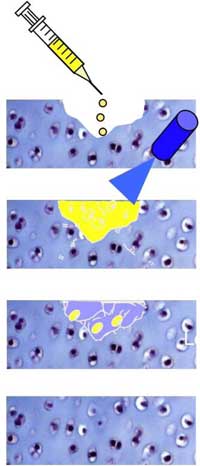
Articular cartilage in joints has limited innate capacity for healing and regeneration. Current surgical approaches for cartilage defects provide inconsistent symptomatic relief and are incapable of regenerating true functional articular cartilage. These include invasive procedures such as OATS (Osteochondral Autograft Transfer System) and microfracture surgery. More recently ACI (autologous chondrocyte implant) procedures have been attempted where cultured chondrocytes from the patient are then injected under a periosteal flap sutured to the area of the defect. However, problems persisit such as hypertrophy, inadequate integration, delamination, and graft failure, related to the ability of the injected cells to be retained in the defect and to remodel and integrate the neocartilage with host. Our approach to this problem is to inject the chondrocytes in a liquid collagen solution containing a photocrosslinker (e.g., riboflavin) and then illuminate with visible light to form a crosslinked gel that conforms to the defect shape and forms a matrix that is suitable for neo-cartilage formation by the encapsulated chondrocytes (11, 12). The schematic of the procedure is shown in Figure 12.
Using this approach we have been demonstrated photoencapsulation of chondrocytes in a crosslinked collagen matrix that resists contraction in non-toxic manner and subsequent chondrogenesis in an implant model. Importantly, the neocartilage integrates to the existing cartilage. |
1. Inject shape conforming collagen solution containing chondrocytes and biocompatible light activated crosslinker |
| 2. Illuminate with visible light to crosslink into stable gel with encapsulated chondrocytes | |
3. Encapsulated chondrocytes produce new cartilage in situ to repair defect. |
|
| 4. Neocartilage integrates with healthy host cartilage to repair defect |
|
| Figure 12. Schematic of the procedure for in-situ encapsulation of chondrcytes for focal defect repair. |
|
Related Publications
11. Ibusuki, S., G. J. Halbesma, M. A. Randolph, R. W. Redmond, I. E. Kochevar, and T. J. Gill (2007) Photochemically cross-linked collagen gels as three-dimensional scaffolds for tissue engineering. Tissue Eng 13, 1995-2001.
12. Ibusuki, S., A. Papadopoulos, M. P. Ranka, G. J. Halbesma, M. A. Randolph, R. W. Redmond, I. E. Kochevar, and T. J. Gill (2009) Engineering cartilage in a photochemically crosslinked collagen gel. J Knee Surg 22, 72-81.
Research Projects
Mechanisms for light activated protein crosslinking
Closure of surgical wounds
Cornea: sealing incisions and transplantation
Peripheral nerve repair
Tendon repair
Blood vessel repair
Neocartilage generation













